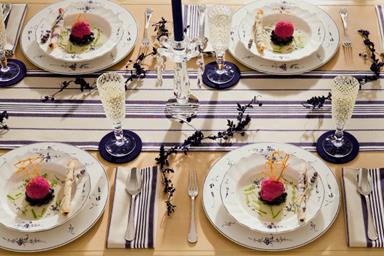Serving Love On a Plate
Living & Lifestyle5 minutes read
3990 views
3990 views
Founded in 1748, German tableware maker Villeroy & Boch opened its first Asian flagship store in Singapore last year. The 140 sq m space at the equally historic Capitol Piazza carries the brand’s famously ornate porcelain products. But beauty is more than just skin deep. We speak to Villeroy & Boch to find out how it’s turning everyday plates and cups into symbols of enduring love through generations.

Mugs from the 'NewWave' collection.
Villeroy & Boch has been around for over two centuries. What’s the secret behind its timelessness?
The value that hasn’t changed over the years is our commitment to innovation. For example, the ‘NewWave’ collection, which debuted in 2001, features a mug that’s sculpted from one piece of porcelain. When you hold the mug, the handle wraps around your hand. The desire was to create a design that’s as ergonomic and pleasing to use as possible. At the same time, we wanted to leave a little room for curiosity with the unique form. Today, the mug is one of our most popular items.

Select tableware from the 'Amazonia' collection.
Some collections feature elaborate artwork. What’s the inspiration for the artwork?
‘Amazonia’, the bestselling collection in Singapore, for instance, is based on the adventures of late explorer and botanist Alexander von Humboldt, who trekked extensively through the Amazon rainforest in the 19th century. He was the first person to describe and record the sights of the jungle in detail, so we felt that his journey was a really interesting thing to capture on our tableware. We like the nature theme because it’s so calming and appreciable by people of all ages.
What’s the role of artwork in your collections?
We try to tell a story with each collection. When you buy a piece of tableware, you’re buying the memories of an artist or the memoirs of a person whom the artist is inspired by. This is something you’d want to serve your family with, passing it on to your children when they get married and finally seeing them pass it on to their kids. We didn’t initially set out to make heirlooms out of our tableware, but it’s what our customers have fallen in love with.
What did your customers tell you?
Once, we had a customer who came into the store and said that his then-girlfriend had bought him a plate from here. She has since relocated to overseas, but using the plate reminds him of their relationship. On a lighter note, another customer commented that she feels like she’s on a tropical vacation whenever she uses the cup from the ‘Amazonia’ collection. We’re heartened to hear these experiences.

Select tableware from the 'Old Luxembourg' collection, which has been around since 1768.
How is the artwork transplanted onto the tableware?
The artwork is assembled by hand onto the tableware. Some collections sport additional features like gold trimmings around the edges, and these are also fixed onto the tableware by hand. Every detail matters to us, and we feel that only human hands can give the attention every piece of tableware deserves.
It seems like there’s a high level of craftsmanship involved. How does this extend into the moulding process?
Moulding is a delicate process, so a portion of it is still hand done to ensure that the tableware meets the quality which we’ve established over the years. When you bake a mould, it becomes much smaller. As a result, building a dimensionally accurate and structurally sound mould comes down to the science of being able to compensate for shrinkage with pinpoint precision. Our workers back in our factories in Germany are trained to do this, so only the best leaves the oven.

Select tableware from the 'NewWave' collection.
What about the materials?
Our premium products are made from bone China, which is porcelain mixed in with the ashes of cattle bones. The newly formed material allows our tableware to be thinner and lighter, yet stronger at the same time. A mixture needs to be constituted of at least 30 percent bone ashes to qualify as high-quality bone China, but we make our mixture from 45 percent bone ashes for extra durability. The material also gives our tableware its pristine whiteness and translucency.
So how do we tell a bone porcelain product apart from a non-bone piece?
You can’t call a product a bone porcelain product unless it really has bone ashes in it. Genuine bone porcelain tableware is usually thinner and lighter than non-bone tableware. For a tell-tale sign, hold the tableware piece up against a light source. If light is allowed to vaguely pass through, it’s a bone porcelain product. If light is completely blocked, it’s a non-bone porcelain product.

Landmarks from Singapore are imprinted on a 'NewWave' mug as part of the 'Cities of the World' collection.
What are your plans for the Singapore market?
Singapore is one of the featured cities in our 'Cities of the World' collection, which imprints the landmarks of over 40 cities onto the 'NewWave' mugs! In addition, we’re always looking to collaborate with more artists to create customised tableware for the local market. Hence, you’ll find that we refresh our lineup from time to time. However, our oldest design is the classic ‘Old Luxembourg’ collection, which has been around since 1768 and still going strong!
|
The House of Villeroy & Boch Singapore |
This story is brought to you by Villeroy & Boch.
Request for quotes and we'll match you with a selection of Interior Designers!
Previous
Platform Beds Are All The Rage Now And This Condo In Serangoon Proves It


 Sign Up with Google
Sign Up with Google

.jpg)